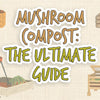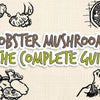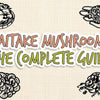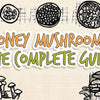Shiitake Mushrooms: The Complete Guide
The second most popular and third most cultivated mushrooms in the world? Enjoyed by Chinese and Japanese Royalty for thousands of years? Shiitake mushrooms with their unique brown cap and milky-white under are as delicious as they are beautiful.
In this guide, we will explore these famous wild mushrooms and uncover why they have been enjoyed for such a long time (since Medieval Asia), their health benefits, where to find them, what to do with them once you have them, and how to prepare or preserve them.
Warning: Although consumed raw in many Asian cuisines, a German study discovered that eating raw shiitake mushrooms causes Shiitake Dermatitis, a skin reaction for people allergic to polysaccharides (link).
Not Much Time? Skip To What You'd Like To Learn...
-
Five Shiitake Mushroom Facts!
-
Five Health Benefits Of Shiitake Mushrooms
-
Commonly Found Types Of Shiitake Mushrooms
-
Differences Between True And False Shiitakes
-
History Of Shiitake Mushrooms As Medicine
-
How To Use Shiitake Mushrooms As Medicine
-
What To Look Out For When Buying Shiitake Mushrooms
-
How To Grow Shiitake Mushrooms
-
Environment Shiitake Mushrooms Grow In
-
Foraging For Shiitake Mushrooms
-
How To Pick Shiitake Mushrooms
-
Why Are Shiitake Mushrooms So Popular?
-
How To Tell If Shiitake Mushrooms Have Gone Bad
-
Cleaning Shiitake Mushrooms
-
How To Store Shiitake Mushrooms
-
Drying Shiitake Mushrooms
-
Pickling Shiitake Mushrooms
-
Shiitake Mushroom Recipes
Five Shiitake Mushroom Facts!

-
They have a rich umami flavor and chewy, meaty texture.
-
After the button mushroom, they are the second most commonly consumed mushroom in the world.
-
Top 5 most profitable mushrooms for farmers to grow.
-
They are mostly farmed rather than forged.
-
Shiitakes have been used for food and medicine in China, Japan, and Korea since 960-1127 CE.
Five Health Benefits Of Shiitake Mushrooms

-
Enhanced Weight Loss - Studies show that shiitake mushrooms support weight loss in animals, with human clinical trials showing beneficial effects in humans (link). According to the study, shiitake mushrooms contain hypolipidaemic (fat-reducing) compounds that reduce food intake and plasma lipid fat levels, mitigate nutrition absorption, and boost satiety.
-
Boost Immune System - Increased intake of shiitake mushroom can increase your cell effector functions and improve your overall gut health according to this study (link). The participants consumed 5 to 10 grams of dried shiitake mushrooms daily for four weeks. Subsequent blood sample results showed reduced CRP (inflammatory) levels and improved cell proliferation (an increase in the number of cells).
-
Source of Vitamin D - Vitamin D boosts bone health, reduces the risk of heart disease, improves absorption of phosphorus and calcium and inhibits autoimmune diseases. You get substantial amounts of Vitamin D2 and D3 from shiitake mushrooms depending on the method of growth.
When grown in decent amounts of sunlight, studies show that the mushrooms provide high contents of Vitamin D3, the vitamin's most bioavailable form (link). If you grow your mushrooms in limited UV light, you get supplemental amounts of vitamin D2, which raises plasma levels by over 50% over a 12-week period according to this study (link).
-
Boost Energy and Improve Brain Function - Shiitake mushrooms contain high contents of Vitamin B2 and B12, essential for an energy boost and improved cognitive function (link).
-
Promote Skin Health - Although consumers with allergies may suffer from Shiitake Dermatitis, the mushrooms contain high amounts of Vitamin A and E. Together with the Selenium, the vitamins help reduce acne severity and skin scarring (link).
Commonly Found Types Of Shiitake Mushrooms

Shiitake mushrooms don't come in a variety of species like morel mushrooms. However, research and increased commercial production resulted in the introduction of three strains that vary depending on the weather they grow best in. They include:
Snow Cap Shiitake (Cold Weather) - This Shiitake strain grows well in cold weather and produces beautiful, brown, uniform, thick-fleshed caps with white lacey pigmentation. The strains heaviest fruiting takes place during early spring and late fall. Their ability to grow over a long outdoor season naturally makes them a favorite for foraging (link).
WW70 Shiitake (Warm Weather) - This strain grows well in warm weather and produces one of the most beautiful ornamentations of the three strains. You get mushrooms with dark-brown caps with a variety of beautiful contrasting dark shades. The strain fruits between late summer and late fall, one of the longest periods of the three strains. The WW70 strain responds poorly to force fruiting, it's prudent to avoid it (link).
Native Harvest Shiitake (wide range) - The NHS strain grows vigorously, fast and for the longest time both in the North and South. The strain first grew on oak but also grows well on Red Maple and other common tree species. Unlike the other wide range strains, the NHS strain offers you a late flush - a bonus for your table during Thanksgiving! This strain's spawn runs 6 to 12 months (link).
Differences Between True And False Shiitakes
False Shiitakes
Cap:
-
An irregular/bent shape
-
Inwards bulging
-
Wavy and lobed
-
Freely hanging from the stem
Interior:
-
When you slice it, a false morel isn't hollow and filled with cotton like fibers inside.
True Shiitakes
Cap:
-
Smooth uniform shape
-
Light-dark brown color
-
Pitted inwards
-
Covered in pits and ridges
-
Directly attached to the stem
Interior:
-
Once you slice your shiitake, it should be hollow from the bottom of the stem to tip of the cap
History Of Shiitake Mushrooms As Medicine

Shiitake mushrooms helped people in Medieval Asia to prevent common colds, fight hunger, and boost energy levels (link). In East Asia, Shiitake Mushrooms were a delicacy preserved for royalty because of their benefits, taste, and cost.
They mostly grew in East Asia, particularly Japan, China, Korea, and Taiwan. Farming of shiitake mushrooms spread to other regions in the 1970s like USA, Singapore, and parts of Europe because of their nutritional and medicinal benefits and commercial viability.
How To Use Shiitake Mushrooms As Medicine

Shiitake mushrooms contain high fat, protein, carbohydrate, mineral, and vitamin content. Some of the medicinal and therapeutic benefits include:
Antitumor Properties - Can prevent and inhibit the growth and formation of tumors (link).
Antimicrobial Properties - May inhibits the growth and reproduction of microorganisms (link).
Antibacterial Properties - Shown to interfere with the growth and reproduction of bacteria (link).
Antiviral Properties - Could help in the prevention and treatment of viral infections (link).
Immunomodulation Capabilities - Helps in the alteration of the immune system into desired levels (link).
Cardiovascular Health Properties - Helps in maintaining sound heart health (link).
Hepatoprotective Properties - Could prevent liver damage (link).
Hemagglutination Capabilities - Could prevent the clumping of red blood cell particles (link).
Shiitake Dosage - The appropriate dosage of shiitake for you depends on a number of factors like your age, health, and allergies. No tangible evidence indicates the right dosage.
Pharmacists advise users to take it according to the directions on the product and consult your physician before use.
Side Effects of Shiitakes - The information about the side effects of consuming shiitake medicine remains scarce. Pharmacists, however, advice pregnant mothers, breastfeeding mothers, and people with blood disorders like eosinophilia (higher than normal white blood cell count) to avoid it (link).
What To Look Out For When Buying Shiitake Mushrooms

Smell - Dried shiitake mushrooms that are edible produce a sulfur-like smell. Fresh ones should produce an earthy smell that is not overly pungent.
Sight - Fresh shiitakes should have a light-dark brown pigment. Dried ones are mild-dark brown in color.
Touch - Fresh shiitakes are damp and spongy whereas dried ones are firm to touch.
How To Grow Shiitake Mushrooms
Although indigenous to East Asia region (Japan, China, and Korea), Shiitake cultivation and production spread to other areas like the United States (link).
Shiitake Mushrooms can be grown at home, but most production is done in large-scale in Japan, China, and the United States. This is why they are the second-most common mushroom species in the world after the button mushroom (link).
Shiitakes grow best on freshly cut logs of hardwood trees (hii' means hardwood in Japanese) like oak and sugar maple trees.
How to Grow Shiitake Mushrooms:
1. Inoculate your logs with the fungus, get plugs (30 to 40 plugs per log), and insert holes drilled into the logs.
2. Fill the plugs with sawdust, fungal inoculum (commonly referred to as pores' or yphae'), and grain material as nutrients for the fungus.
3. Seal the holes with bee or cheese wax or paraffin and keep these inoculated ones off the ground and in 80-100% shade.
4. The fungus requires moisture from the wood to grow so during dry weather, always wet the logs well.
5. Your logs need 8 to 18 months for the fungus to grow through, and it should eventually fruit to produce shiitake mushrooms on its own.
You can watch this YouTube video for more details (link).
“Shocking” Your Shiitakes:
You can shock or force your shiitakes to grow faster by:
1. Soaking your logs in cold water for 12 to 24 hours during warmer months.
2. Maintain them in 50 degrees minimum night temperatures.
3. Once shocked, stack your logs in A-frame arrangement or at an angle against a structure.
4. If fruiting fails to occur in weeks, you need to shock your logs again.
5. If they have fruited, wait 6-8 weeks and shock again.
6. You should see small white dots or bumps called pins. Pinning is the early process of mushroom growth.
7. From this point until harvest, keep your logs covered with a blanket and a canopy or plastic bag during rainy weather. Too much water causes waterlogged, saggy shiitakes.
(link)
Want to know our Top 10 Mushrooms Growing Kits? We have a full and comprehensive guide to the best growing kits and considerations before buying one too! Check out our Top 10 Mushroom Growing Kits Here.
Environment Shiitake Mushrooms Grow In

Seasons - Because of their popularity and commercial viability, shiitakes grow throughout the year. There are different strands ideal for warm, cold and mild weather conditions. The best planting time, however, is between late summer and late fall.
Shaded/Lit Woodlands - Your shiitakes can grow in both lit and shaded environments. Shaded environments offer faster growth whereas lighted ones offer shiitakes with higher nutritional value.
Soil - Your shiitakes grow well on logs compared to soils. Sawdust replaces soil in many commercial production areas for faster growth and production of quality mushrooms.
Foraging For Shiitake Mushrooms
When foraging we would always recommend using mushroom knife for ease of use, and a clean cut. Interested in learning more about mushroom knives? Click Here For The Complete Guide To Mushroom Knives
Country - Shiitake Mushrooms grow wild in parts of Asia (China, Japan, and Korea) and are cultivated in the United States.
Time - In Japan (the largest producer of shiitakes), shiitake cultivation takes place during spring (March to May) and autumn (September to November). In China, shiitake growth happens during spring (mid-March to mid-May) and autumn (September to November).
In the US, shiitake mushrooms are spread in various states, produced in private farms for commercial purposes. Like in most other shiitake producing countries, production can be annual when the mushrooms are subjected to specific environmental conditions.
Climate - You get the highest shiitake mushroom yields during the hot and wet climate, between late summer and late fall.
Environment - Shiitakes grow on dead hardwood trees in a warm, moist environment. A combination of warm temperatures and high rainfall induces increased growth of shiitake mycelium, from which the mushrooms grow.
Individually and In Groups - Shiitake mushrooms grow individually at first and in cluster groups as the yield increases with time.
How To Pick Shiitake Mushrooms

Appearance - Fresh shiitakes have large, dark-brown, umbrella-like caps with relatively slender, cream-colored stems. Your mushrooms should have a meaty texture and earthy complexion.
Use A Sharp Knife - Make sure to cut the stem close to the cap carefully with a sharp knife.
Keep Dry and Clean After Cutting - Ensure you don't bruise or soften you shiitakes since damaging them makes them rot quickly.
Want to find the best mushroom knife? Check out our Top 10 Mushrooms Knives article here (link).
Why Are Shiitake Mushrooms So Popular?

Medicinal and Nutritional Benefits - Shiitake mushrooms offers some of the most beneficial health and medicinal benefits of any edible mushroom species. Shiitakes usage dates back to Medieval China, shiitakes helped prevent the common cold, increase energy, and ward off hunger.
Rich in Vitamins - Shiitakes are a source of vitamins A, B2, B12, C, and D, calcium, copper, iron, selenium, manganese and zinc. Shiitake intakes boost your immune system, help you shed weight, offer optimal energy levels, boosts heart health, and inhibits microbial organisms.
Time Frame - Because of their popularity, shiitakes grow all-round the year in controlled conditions in countries like China, Japan, Taiwan, the US, and Korea. Naturally, they thrive in East Asia during the spring and autumn seasons.
Fairly Easy To Cultivate - Compared to other mushroom species like morels, shiitakes cultivation is fairly easy. This is also the reason they are the second most cultivated mushrooms after button mushrooms.
Affordability and Taste - Shiitake mushrooms taste great with numerous recipes and cost less ($5-7 per pound) compared to other mushroom species like the chanterelles ($224 per pound), truffles ($3,600 per pound) and morels ($254 per pound).
How To Tell If Shiitake Mushrooms Have Gone Bad
Sight - Look for puckering and wrinkles on the cap and stem skin. These indicate that your mushrooms lack internal moisture, hence past their prime time (link).
Touch - Press your finger on the mushroom top and release. If it remains pushed in, your mushroom is going bad. If it bounces back, your mushroom is still fresh (link).
Smell - Examine your shiitake mushroom for signs of slime, a smelly liquid that indicates your mushroom is decomposing.
Cleaning Shiitake Mushrooms

For longer preservation, avoid cleaning or rinsing your shiitakes until just before use (link).
Dry Method - Gently shake off as much dirt as possible. Avoid too much shaking to prevent breakage, inspect for more dirt and possible breakage.
Wet Method - Soak your shiitakes in a bowl of salty water, delicately remove any dirt, carefully drain and rinse your mushrooms. Allow them to lay on a kitchen towel for a few minutes to dry.
How To Store Shiitake Mushrooms

Fresh Shiitakes
1. Pick through the fresh mushrooms and discard wrinkled or slimy ones
2. Place dry shiitakes in a paper bag and fold gently without sealing
3. Indicate the date of purchase on the bag
4. Store the shiitakes in the paper bag for 5-7 days refrigerated
Dried Shiitakes
1. Put dried shiitakes in an air-tight container
2. Indicate the date you packed your mushrooms
3. Your container can stay in the freezer for 6 to 12 months
(link)
If you're interested in finding out more about storing mushrooms, check out our article here (link).
More information can be found about freezing mushrooms here (link).
Drying Shiitake Mushrooms
Drying is one of the best ways of preserving your shiitake mushrooms. You can either use machine or oven drying or use sunlight during high summer temperatures.
Read more about drying in our article here (link).
Pickling Shiitake Mushrooms

Inspired by Chef Roberto (link)
Ingredients:
3 large fresh shiitake mushrooms, sliced
150 ml of rice vinegar
2 whole star anise
7 tbsp water
2 tsp sugar
1 tsp cilantro seeds
1 tsp pink pepper
1 tsp salt
Directions:
1. Put all ingredients, except mushrooms, in a saucepan over low heat for 5 to 7 minutes.
2. Place the mushrooms in a bowl and add the hot marinade over mushrooms.
3. Marinate for at least 20 mins before you transfer them to a sealed glass container.
4. Serve with pizza, salads, and sandwiches
For more information about pickling and canning, check out our article here (link).
Shiitake Mushroom Recipes

Stir-Fry Shiitake Mushrooms
Inspired by Philos Kitchen (link)
Ingredients:
2 lb shiitake mushroom
1 tbsp dark soy sauce
2 tbsp oyster sauce
2 cloves garlic
1 tbsp roasted sesame seeds
3 tbsp light soy sauce
2 tbsp coriander seeds powder
3 tbsp sesame oil
Directions:
1. Wet clean your shiitake mushrooms, discard the stems and brush the caps.
2. Rinse with running water and then dry them immediately with a clean cloth.
3. Peel 2 cloves of garlic, and sauté them along with sesame oil, until pale golden.
4. Pick the garlic out and save it in a bowl.
5. Raise the flame and stir-fry your mushrooms continuously for 5 minutes.
6. Add the soy sauces and oyster sauce, and the coriander seeds powder. Continue cooking and stirring for 5 more minutes.
7. Reduce the flame to medium, add the roasted sesame seeds, sautéed cloves of garlic and cook a couple of minutes more.
8. Serve immediately.
Sautéed Shiitake Mushrooms
Inspired by Bon Appetit (link)
Ingredients:
2 tbsp olive oil
8 oz stemless shiitake mushrooms
1 cup teriyaki sauce
1 tbsp oyster sauce
water
Directions:
1. To a pan add oil and heat on medium.
2. Add mushrooms and cook for 8 to 10 minutes, tossing occasionally, until tender and golden brown.
3. Add around 2 tbsp water and cook for another minute tossing mushrooms occasionally until water is evaporated and mushrooms are tender.
4. Transfer the mushrooms to a medium bowl and toss with teriyaki sauce and 1 tbsp oyster sauce.
5. Serve immediately.
Shiitake Bacon
Ingredients:
1/2 lb shiitake mushrooms
1 tsp soy sauce
1/4 cup olive oil
Directions:
1. Turn oven on and heat to 350 degrees F.
2. Stem the mushrooms and slice into 1/4 inch slices.
3. In a bowl mix the mushrooms with the olive oil and soy sauce.
4. Spread your shiitakes out in a single layer on a baking sheet and bake for 10-20 minutes until you get the crisp/chewy balance you prefer.
5. Serve immediately.
Stir-Fried Tofu with Shiitake Mushrooms
Inspired by SOS Cuisine (link)
Ingredients:
12 shiitake mushrooms
500g firm tofu, cut into 2cm cubes
1/4 cup sunflower oil
1/4 cup canola oil
1/4 cup soy sauce
4 tbsp sesame seed oil
2 tbsp ginger, grated
4 cloves garlic, minced
2 1/4 cups snow peas
2 zucchini, cut into rounds
2 green peppers, cut into strips
5 tsp sesame seeds
4 scallions, chopped
salt and pepper
1 tsp honey
Directions:
1. Mix your sesame seed oil, sunflower oil, soy sauce, and grated ginger in a shallow bowl.
2. Cut and add 2 cm cube tofu to the marinade.
3. Mix properly and chill the mixture in the refrigerator for at least an hour or overnight.
4. Preheat your oven to the lowest temperature.
5. Mince garlic, cut pepper into 5mm strips, cut zucchini into rounds, and snow peas into bite-size chunks.
6. Discard the stems and cut you shiitake caps into quarters.
7. Heat 1/8 cup of the canola oil in a skillet and add tofu cubes.
8. Sauté for 5 minutes with frequent stirring until golden brown.
9. Remove and set aside.
10. Add the remaining canola oil over medium heat.
11. Add garlic and sauté for 1 min then add all the vegetables (except scallions), and sesame seeds.
12. Add salt and pepper to taste.
13. Cook for 6-7 minutes until your vegetables are cooked.
14. Pour the reserved marinade and the honey in.
15. Put your tofu back into the wok and cook a few more minutes while stirring.
16. Sprinkle with the chopped scallions and serve.
Asian Style Chicken and Mushroom Wraps
Inspired by Cleveland Clinic (link)
Ingredients:
3 ounces shiitake mushrooms, without stems and thinly sliced
1 lb coleslaw mix
1 tsp sesame oil
1 cup shredded chicken
5 scallions, 3 inches of the green, thinly sliced
4 8-inch whole wheat tortillas
3 tbsp hoisin sauce
1 tbsp minced fresh ginger
1 garlic clove, minced
1 tsp garlic chili sauce
Directions:
1. Heat the oil in a large pan.
2. Add your chicken, mushrooms, coleslaw mix, scallions, garlic, and ginger.
3. Heat until stir-fry has wilted
4. Stir in the garlic chili and hoisin sauces.
5. Prepare and preheat your tortillas in the microwave following package directions.
6. Place 1/4 of your chicken and vegetables in each wrap.
7. Roll up and serve immediately.
Shiitake Mushroom Soup
Ingredients:
6 cups shiitake mushrooms, chopped
8 cups vegetable broth
1 tbsp apple cider vinegar
6 cups cauliflower, chopped
2 cups onions, chopped
1/2 tsp salt
Directions:
1. Place all ingredients into a large pan and bring to a boil.
2. Reduce heat and cook for 20 minutes.
3. Puree with immersion blender until smooth.
4. Serve warm.










Great site 👍🏻
I would like to know how to tell if dried shiitake mushrooms have gone bad.